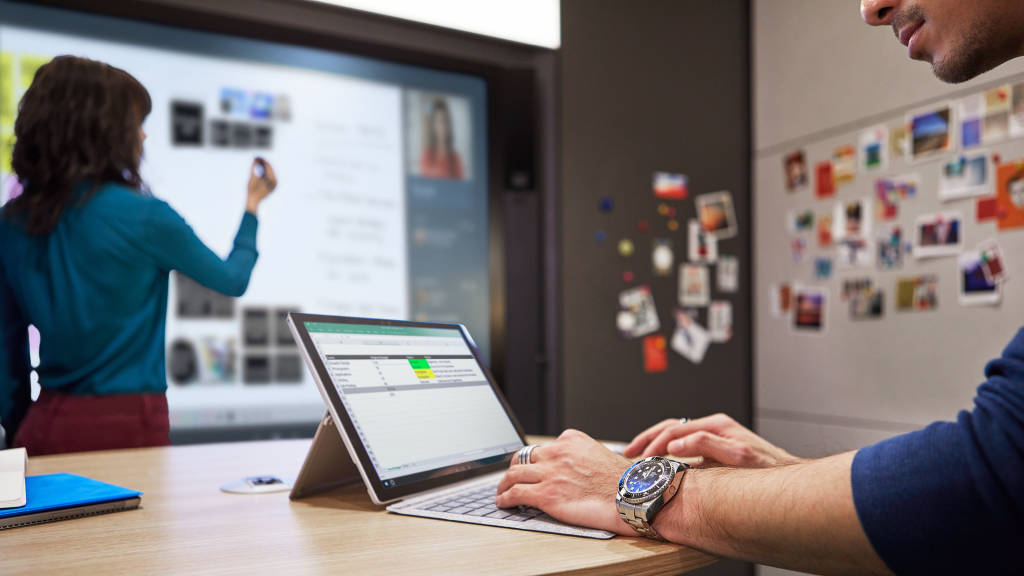Hacking Our Workspaces
Microsoft and Steelcase get messy hacking — and finding a new approach to the future of collaboration in the process.
The Microsoft Hackathon is a gigantic worldwide event with employee participation from 70,000 people across 80 countries. In prior years, the Hackathon buzzed with energy as thousands of teams rolled up their sleeves to tackle big, complex problems in 48 hours. Much of that energy came from passionate people being together in giant soccer pitch-sized tents or jammed into shared workspaces. But this year, Mike Pell, a Microsoft Envisioneer based in NYC, and the Microsoft Garage team needed to hack their own event to flip all of this experimentation, learning and innovation to a fully virtual, online-only platform for the first time.
“There’s a big misconception that you have to know how to code to hack. Not true! Hackathon is for everyone. It’s about getting messy, making steady progress and finding breakthroughs together.”
Mike Pella Microsoft Envisioneer and Director of the Microsoft Garage in NYC
For this challenging seventh annual Microsoft Hackathon, Pell invited Steelcase to get in on the action. Gale Moutrey, global vice president, Brand + Workplace Innovation, put together a diverse team from the U.S. and Canada to approach a highly relevant issue facing lots of organizations right now — distributed collaboration. The team decided to push the issue with this prompt: How might a blended team (both co-located and distributed) have higher performance than an all-remote or all-in-person team?
“The hack put us in the position of our customers. We approached this challenge around blended collaboration by experimenting on and learning from ourselves.”
Gale MoutreyGlobal Vice President of Brand + Workplace Innovation, Steelcase

360 sat down with Pell and Moutrey to get answers to all of our Hackathon questions.
360: How does Microsoft work hand-in-hand with outside teams to facilitate the Hackathon?
Mike Pell: The point of the Hackathon is to work collaboratively across boundaries in a fast, messy, and non-traditional way to figure out how to move our ideas forward. We’re very open and transparent with hack project ideas across the company, which is why every hack project produces a short project video to share by the end of the event. This year, we paired up more than 2,000 experienced Microsoft hackers with outside teams and employees new to hacking to answer questions from hackers on demand. We built our own infrastructure to support this large-scale virtual experience so teams could upload videos, share ideas, vote on concepts and more.
360: How did Steelcase approach the challenge of blended collaboration?
Gale Moutrey: Our team included some people working together in our Grand Rapids office and some who were remote. So, the blended approach was both challenging and our own challenge. We started by thinking about what makes a really great, high-performing team — things like efficient problem solving, a sense of togetherness, feeling energized, equal participation, accessing intuitive tools and getting into flow quickly. We got into a creative rhythm — defining our problem together, and then breaking into small groups before coming back as a team. We focused on principles we could follow to create a better team collaboration experience. Physical objects like 3D models helped us communicate both the physical and digital worlds. Technology allowed us to connect, but the physical models allowed us to express our thinking and structure our storytelling.
360: What did you learn about blended collaboration that might help others?
MP: I learned it’s not at all about the digital toolset, it’s about how the ingenuity and creativity of people make it work. There are lots of technical features available, but teams have to figure out how to be creative and develop habits and behaviors over time. I love seeing people use technology in new ways. I saw one team working in Microsoft Teams tile view and the moderator said, “Write something on a piece of paper and hold it up.” That simple idea immediately equalized participation and illuminated a new way of collaborating.
GM: Over the course of the two days, we saw how people in the room began to have more empathy for those of us joining remotely. At first, those of us at a distance were pushing ourselves into the room — telling people we couldn’t see or hear. But by the second day, everyone started to manipulate the technology to reach out to us. They would open their laptops or cell phones just to give us a better angle and help us participate.
360: How might your hack change the way we view the future of work?
GM: We know in the future people will be toggling between an ecosystem of places — their office, home and possibly other satellite locations. We believe blended collaboration experiences that entice, engage and extend the impact of the team will braid digital with analog and AI with human touch.
Imagine walking into a room and it recommends analog and digital tools based on the type of collaboration you’ll be doing. Room dashboards could sense connection and wellbeing, and provide for greater understanding of the team’s collective energy, cognition and wellbeing. The physical space intersects with the digital tools to act as team facilitator and coach, making it easier for everyone to participate equally. The room may guide the team saying, “Jane has her hand up” or “Tom hasn’t spoken in a while.” The space will extend the impact of the team through capturing, consolidating and sharing their generative work as well as monitoring and measuring their wellbeing and their ultimate achievements.
MP: Considering the room an “entity”, always paying attention and being proactive, was a real breakthrough during the hack. It was almost completely ignored before that idea. Computers are really good at some things and not at others. They are excellent at monitoring. So, thinking about how the physical environment can be an active and equal participant by leveraging ambient computing is exciting because it considers the use of space in a completely new way.
 Gale Moutrey is global vice president, Brand + Workplace Innovation for the Steelcase family of brands. In her role Gale travels the world, physically and virtually, speaking with customers, design professionals and leading organizations about the changing nature of work and the important role of the workplace. A graduate of the University of Toronto, Gale has held a variety of communication, marketing and sales roles since joining Steelcase in 1983, and lives in Toronto, Canada.
Gale Moutrey is global vice president, Brand + Workplace Innovation for the Steelcase family of brands. In her role Gale travels the world, physically and virtually, speaking with customers, design professionals and leading organizations about the changing nature of work and the important role of the workplace. A graduate of the University of Toronto, Gale has held a variety of communication, marketing and sales roles since joining Steelcase in 1983, and lives in Toronto, Canada.
 Mike Pell is an envisioneer and director of the Microsoft Garage in New York City. He leads Design for The Garage worldwide, and has previously led Microsoft’s official “experimental outlet” program which helps small teams of passionate employees get their ideas into the hands of customers as experiments. Experienced entrepreneur, startup veteran, and inventor of Adobe Acrobat and PDF, he is also the author of “Envisioning Holograms” (2017) and “The Age of Smart Information” (2019).
Mike Pell is an envisioneer and director of the Microsoft Garage in New York City. He leads Design for The Garage worldwide, and has previously led Microsoft’s official “experimental outlet” program which helps small teams of passionate employees get their ideas into the hands of customers as experiments. Experienced entrepreneur, startup veteran, and inventor of Adobe Acrobat and PDF, he is also the author of “Envisioning Holograms” (2017) and “The Age of Smart Information” (2019).


